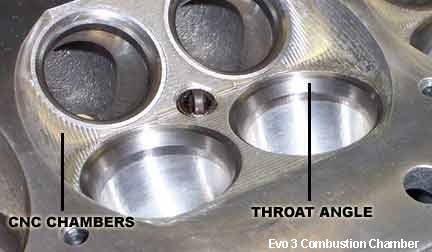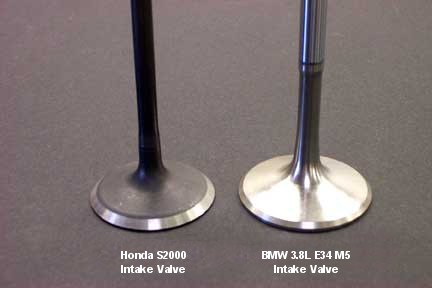
|
|
According to the cylinder head technician who tested the heads for this article, the first thing he noticed about the Evo 3 cylinder head is that the intake ports have a very steep entry (see comparison to the Honda S2000 port entry above). From his experience multi-valve heads with steep entries tend to flow better at lower lift values. This is borne out by the test results as the Evo 3 head does indeed flow better than the Honda S2000 head at lower valve lifts. Also, his initial impression was that the volume of the Evo 3 intake ports was rather small at 122 cc. This is a value that would be characteristic of a stock Honda B16 or 1600cc engine. He predicted that the Evo 3 intake ports would choke relatively early. This prediction is also borne out by the test results. The S2000 cyl. head continues to flow better at higher lift values when the Evo 3 head has already plateau'd. Tech Note: With input from E30 M3 owner and tester Stan Marcy we learn that the standard 2.3L S14 head sports 26 mm diameter inlet ports. The 215 HP S14 cylinder head, as well as the Evo II and Evo III heads feature 28 mm diameter inlet ports. This is also confirmed by other sources. The Euro 3.8L E34 M5 head incorporated 29.2 mm diameter inlet ports. From a European contact we learn that the 1991-1992 2.5L DTM cylinder heads had 32 mm diameter intake ports (in conjunction with 38 mm intake and 32.5 mm exhaust valves). Ports of this size required a special DTM casting in order to provide enough "meat". |

|
|
The configuration of the valve seat region is critical to the flow capacity of a cylinder head. Much more so then one might intuitively believe. In this regard, the cylinder head technician found that the Evo 3 throat angle is both steep and long. Curiously, his experience is that such a design would tend to promote flow at very high lifts (0.500" and above, American V8 territory). Since the Evo 3 head did not flow well at high lift, he feels this lends credence to his theory that the port volume is too small on the intake side. Conversely he felt that the 45° valve seat was much too thin, which would hurt flow at high lifts. The back-cut length and angle is ok he feels. Keep in mind that these are his opinions, which are based on extensive experience with tuning Honda cylinder heads. This was his first look at a BMW head. |

|
|
Regarding the 38.5 mm intake valve from the Euro 3.8L E34 M5, which has a stem that necks down to 6 mm in the port area (vs. 7 mm for the rest of its length), the flow technician felt this valve was very heavy at 71 gm. If you ever have a chance to hold a Honda valve and a BMW valve in your hands at the same time you will see that the BMW valve is very robust when compared to the Japanese product. The technician also felt that the smaller 6 mm stem size was not such a benefit in terms of flow, but was more a benefit in terms of mass. Honda valves are very lightweight, which may explain why their engines are able to sustain very high rev's with large lift values and yet still retain valvetrain integrity. So, based on the results presented here, one might wonder: Could an S14 cylinder head could be made to flow as well as a Honda S2000 head? And if it could, would bolting this head onto an S14 engine make more power? It's difficult to know for sure, only the dyno would really tell... |
|
« Back |